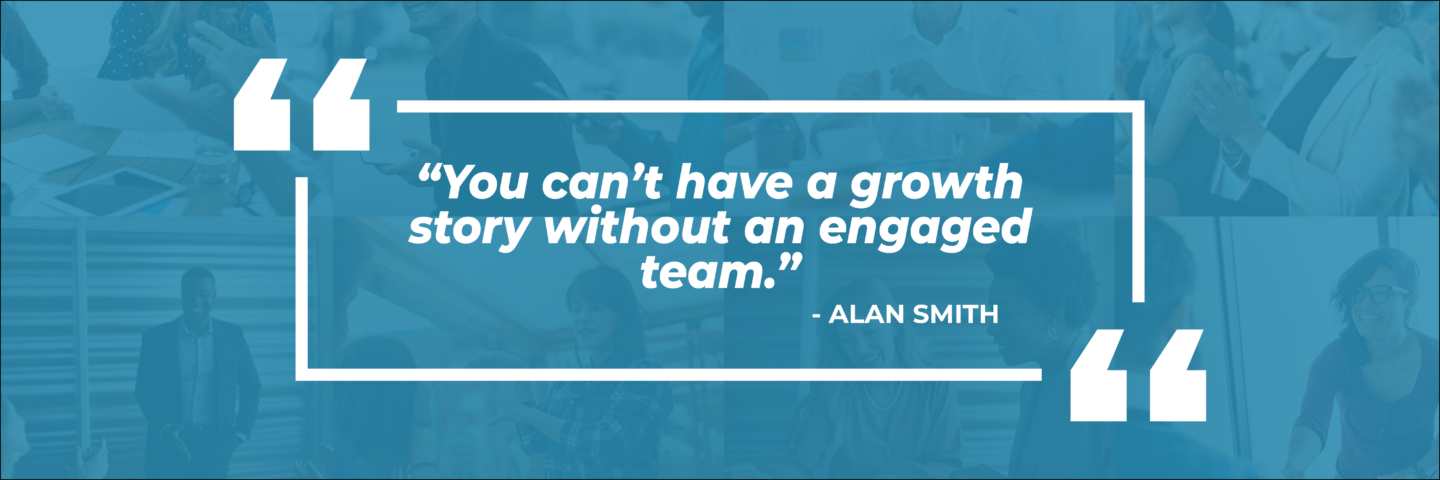By his own admission, Alan Smith, founder, and CEO of London-based Capital Asset Management is a data-driven numbers guy. However, he’s also a big believer in culture as a business driver.
“I’m a voracious reader. I read about other successful entrepreneurs. And time after time, the thing you find in common is this idea of high-quality culture within an organization,” he said on a recent webinar hosted by Engagement Multiplier. “Right from the get-go, I was keen to develop a company with a strong brand and a strong internal culture. There’s any number of research, papers, and studies that do show you companies with a strong internal culture tend to perform better. If it is about the bottom line, and about data and revenue, well guess what, there is a provable correlation between strong culture businesses and success.”
“If your team is not engaged, then you’re pushing water up a hill,” continued Smith, when asked about the importance of employee engagement. “A team or company is just a group of human beings, a group of people. There’s a great statement by one of the leading business thinkers, Patrick Lencioni. He says, “If you could get all the people in an organization rowing in the same direction, you could dominate any industry in any market against any competition at any time.”
“I think that just sums it all. With the whole team rowing in the same direction, you can take on the world. There’s nothing that will hold you back. The trouble is most organizations haven’t got that. They’ve got a few people who are all ready to go and get behind the vision and the plan.” But many others, he notes, are not bought in at the least, and at the worst, they may be detractors, who are actually holding the organization back.
“My ideal is to have 100% of the team onboard and headed in the same direction because then you can take on the world. You can achieve a heck of a lot,” said Smith. “And the starting point is making sure the team is engaged.”
“You can’t have a growth story without an engaged team.”
Quantifying and reviving engagement
Smith’s firm bears many of the hallmarks of strong, healthy company culture, including low staff turnover, strong collaboration, and a positive, collaborative atmosphere- to the extent that lockdown posed a unique challenge to his team.
“I think that we were at a disadvantage compared to other organizations where the culture was less good,” he said, reflecting back on the first lockdown in the spring. “We just had a great spirit in the organization and people were friendly to each other, we had social events, we would meet up, we would go for lunch or go out of an evening. Our office is right in central London so there’s no shortage of things to do after work. And all of a sudden we didn’t have that anymore.”
Smith notes the team was still highly functional even as they made the switch to working remotely overnight. “But that sort of imperceptible relationship that we all had, the so-called water-cooler moments, those little “Have you got five minutes, I want to run an idea past you” conversations – they just disappeared.”
“We were in a position where we actually were suffering from the lack of contact, the lack of collaboration, the lack of being together,” he continued. “which is why the timing of us first engaging with Engagement Multiplier was quite helpful.”
Capital Asset Management began using Engagement Multiplier shortly after the first lockdown, employing our “Working From Home & Winning” survey to check in on their team, using a system with ready-made rigor to establish a benchmark.
“For us to be able to introduce this process, it paid a lot of dividends,” Smith told us. “That serves a historical position.”
Key to Success: Anonymity
Smith prefaced the discussion of this team’s survey results by emphasizing the importance of the total anonymity the Engagement Multiplier platform affords employees to the overall success of the engagement program.
“The thing that cannot be overemphasized is the anonymity. As the person who receives this information, I don’t know who sent it,” he noted. “Someone won’t always give you the unvarnished truth when you ask. They may not think it’s in their best interest to tell the truth.
But given a framework and a platform, people are more likely to share.”
Smith also noted the value of the Secure Follow-Up feature, which enables leaders to respond to employee comments and feedback within the platform, while still maintaining total anonymity for the employee.
“Because of the technology, if somebody raises a specific issue, the leadership team can reply to them without knowing who they’re replying to,” he said. “That’s really helpful. We don’t know who said it, but we can respond to individual issues, requests, or questions.”
Hear from Alan Smith, CEO of Capital Asset Management & Stefan Wissenbach, Founder & CEO of Engagement Multiplier
Building credibility by following up
Smith noted the framework that Engagement Multiplier provides leaders helped the company commit to following up on survey feedback, something that had not happened when the company had previously attempted to survey the team using simple survey tools.
“The follow up was vital,” he commented. “And that was where the credibility in this lay.”
Clear themes emerged from the company’s first survey results: employees were concerned about their jobs as the effects of the pandemic were being felt worldwide, and they sought more communication from the leadership team. Based upon that feedback and using guidance from Engagement Multiplier, the leadership team developed and rolled out an enhanced communication plan, and also reached out to the staff on an individual basis to reassure them about their jobs and the company’s future.
(Read a full account of Capital Asset Management’s engagement journey – and the results they have generated – here: How A Good Company Got Even Better)
Six-figure impact
The feedback led the company’s operations director to hatch a plan to tackle several issues – including the fact that employees missed collaborating in-person – all at once, giving rise to “Collaboration Days.” Taking steps to create a socially-distanced and safe workspace, the leaders invited the team to come in for a daylong workshop focused on resolving one specific issue. In-person attendance was optional – and all employees opted to attend. At the end of the first Collaboration Day, the team had rebuilt an onerous process, shaving days off the required time.
The company has had a total of five more Collaboration Days since then, and the results have been profound: people are stepping up to suggest and lead the projects, and the results have been fantastic: Smith estimates the savings the various process improvements will deliver at more than six figures.
“The compounding effect of improving six different processes that we do in the company, reducing the time from the start to finish by two thirds, that’s material,” says Smith of the Collaboration Day impact. “That hits your bottom line. That’s about improving profits.”
Valuable work that ultimately saves time
Asked about the time investment he’s made in employee engagement, Smith notes that at the outset, there is more work.
“In the short term, this does create more work, but it’s good beneficial work,” he tells us. “As themes emerge from the feedback, it’s actionable. But in the longer term is likely to lead to hours saved and other benefits.”
When asked to elaborate on how employee engagement activities can result in time savings, Smith had ready answers. Decreases in staff turnover and related disruption, as well as the time and cost of recruiting and training replacement hires, topped the list.
Differentiating the company for recruits
Smith is also making use of the company’s employee engagement data within the recruiting process, using the company scores and engagement plan to prove the health of the culture to recruits.
“Now I’ve got something to say when asked about the culture,” he says. “I can show something that’s factual, evidence-based, data-driven, that shows how we score across all other types of employers in this country and around the world – which is more than me just saying come and join us, it’s wonderful over here. The people I’ve been speaking to have been very impressed with that. They like the idea that it’s differentiated, and it’s factual, which makes all the difference.”
To learn more about Capital Asset Management’s journey with Engagement Multiplier, read Employee Engagement: An Inside Look at the Impact.



